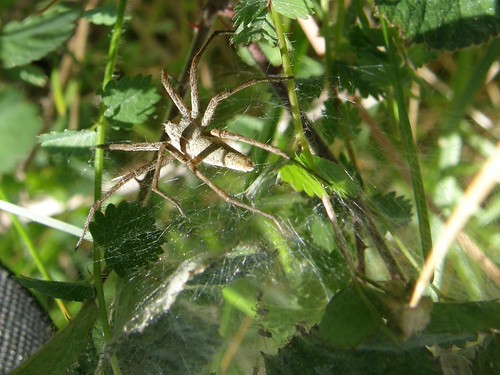
Last Thursday afternoon. Glorious sunshine of course. A post-work walk up perhaps the quietest of the little limestone hills in the area, Haverbrack.

This could be giant bellflower – it certainly looks like the plant I saw around this time last year which I thought could be giant bellflower.

Haverbrack reaches a towering 110m above sea level. But it delivers a great deal of bang for its buck.

Milnthorpe Sands, the River Kent, Whitbarrow and the Eastern Fells of the Lake District.
From the top of Haverbrack a path provides a narrow ride through the woods which once again proved to be very rich in minibeasts.

I think that the two spots make this a male meadow brown whereas the one I had photographed a week before was female.

Leucozona locurum.
Whilst chasing after decent shots of butterflies and hoverflies I noticed some bramble leaves apparently cocooned in gossamer. I brushed the web to see what would happen…

…and this pisaura mirabilis came scuttling round from the underside of the web. I didn’t notice the tiny spiders which you can see in the lower part of the photo. But then I began to notice that there were many more of these webs – or, as it turns out, nests….

Each was similar: a fist sized ball encasing some leaves, often at the end of a ground-hugging branch; within the ball a smaller dark ball, which would separate into many tiny spiders as I approached…

and a white lump…

…perhaps the remnants of the egg-case that the female spider carried around until the eggs were almost ready to hatch.

When I noticed the spiders and webs I was actually trying to get close to this skipper….

…which I think might be a large skipper (which also makes me think that I may have misidentified the photo of the other skipper I posted recently, which I now suspect was probably a large skipper too.)

A many-hued green-bottle.

This hoverfly is one of many species which imitate wasps and I wouldn’t like to hazard a guess as to which one it is.
This one however…

…looks like it’s trying to pass itself off as a bumblebee. I wondered whether it might be one of the many forms of Merodon equistris which is enormously variable because different individuals imitate several different species of bumblebee. But – I left a request for help with identification on the Dipterists Forum and the word has come back that this is a male Eristalis intricaria which is another variable species which imitates bumblebees.
I’d already seen and photographed a red admiral, when a second arrived, flew close over my shoulder and then apparently disappeared. In fact it had landed on the back of my shirt. Reasoning that it therefore was probably not too frightened of me, I decided to see how close I could get for some photos.
Very close:



I wondered whether the gossamer used for the spider’s nests, might have different properties that that used for webs, because this grasshopper..

…didn’t seem to be in the least bit worried by the proximity of either the nest or of the many spiders within.






































 And had a little walk to the pond-dipping area.
And had a little walk to the pond-dipping area.









































